As businesses acknowledge the value of business analysis – the result of the absolute necessity to drive innovation through projects – they are struggling to figure out three things:
- What are the characteristics of their current BA workforce, and how capable does their BA team need to be?
- What is needed to build a mature BA Practice?
- How are we going to get there?
This article focuses on #1: What are the characteristics of our current BA workforce and how capable does our BA team need to be? Also see our March and April Blogs for more information on BA proficiency.
How capable do I need to be?
Your challenge is to close the gaps in your BA capabilities to meet the needs of your organization’s complex 21st century projects. What will it take? Are you up to the task? Reading some of the comments from recent articles, many organizations are still keeping their BAs in very tactical roles. And recent research conducted by Ravenflow confirms we have a lot of work to do to become strategic analysts.
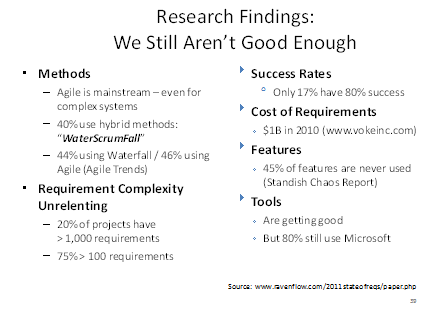
The Challenge: Close the Gap in BA Capabilities
For BAs to elevate themselves into strategic analysts and be seen as valuable corporate assets, they need to start grooming themselves right now to be prepared to meet their organizations’ needs. The trends are promising: “Your future business/technology analysts will be the most valuable business analysts, because they can single-handedly turn business-requested IT-delivered applications into tomorrow’s dynamic business applications,” write Schwaber and Karel of Forrester Research, Inc. [i]
How do I know if I am Capable Enough?
Your organization needs to ensure it has appropriately skilled BA workforce possessing the capabilities needed to successfully deliver innovative products and new business solutions that meet 21st century business needs. So how do we gauge individual and workforce BA capability that is commensurate with project challenges? More and more BA Practice Leads and Managers are conducting an assessment of their entire BA Workforce Capabilities taking into account the complexity of their portfolio of projects. Projects typically fall into four areas, with complexity growing as we move from left to right in the model below, which describes the project levels: (1) operations and support changes delivering enhancement to current business processes and technologies, (2) projects creating new or changed processes and technologies, (3) enterprise change initiatives that implement strategy to transform how the organization does business, and (4) innovation and competitive focused initiations to forge new ground.
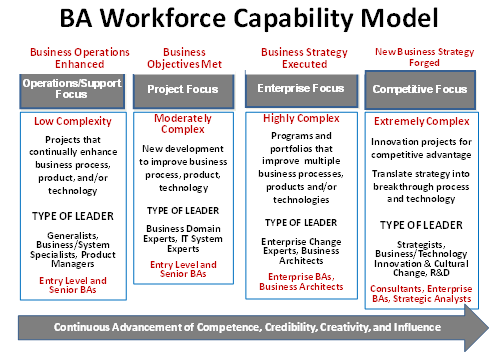
Competency vs. Capability
It’s not just about competency (what you think you can do or your score on a multiple-choice knowledge assessment); it’s ALL about capability:
Ensuring your competency level and capability to perform is commensurate with the complexity of your current and future work assignments, andAbility to perform to achieve forecasted project outcomes and resulting business value within your organizational context.
To determine the characteristics of your current projects and your BA capabilities (and those of your BA peers), the BA Individual and Workforce Capability Assessment identifies your capability gaps, and proposed a plan to close the gaps. The knowledge, skills, techniques, and capabilities behind the model are based on the latest industry research about business, leadership, complexity, innovation, and creativity. In addition, it is in alignment with the IIBA® BABOK® Version 2 and the IIBA® BA Competency Model Version 3.
So, how capable do you need to be? The Answer: It Depends…
… on the complexity of your current and future work assignments. So let’s examine the model in a little more detail. The Applied BA Capability Model is four-tiered; each tier requiring different BA competencies based on the project complexity, the innovation required, and the focus of work assignments. As you move across the model from left to right, projects become more complex, and therefore, more sophisticated capabilities are required for success. The four tiers include four levels of business focus:
- Operations/Support Focus
- Project or New Product Focus
- Enterprise/Strategy Execution Focus
- Competitive/Future Strategy Focus
Level 1: Operations/Support Focus
These BAs typically spend their time doing BA activities for relatively low complexity projects that are designed to maintain and continually improve current business processes and technology. Many BAs operate at this level, since studies show that IT organizations spend 70% to 80% of their budget and resources just to “keep the lights on” – maintaining business as usual. This only leaves 20% to 30% of resources left for innovation. IT organizations have been trying to flip this ratio for years, and many are succeeding. Hence, fewer BAs will be needed at this level, and more will be needed for more strategic, innovative projects.
BAs working to at this level need to view the effort as a large project looking at the entire system; examining the opportunity to creatively change and improve rather than looking at the task as simply fixing bugs or problems. Prioritize change requests based on business value. Once a systems and business-value approach is used, opportunities for innovation begin to emerge.
As legacy processes and systems age, these business analysts are becoming more and more valuable since they are likely the best (and often, the only) SMEs who fully understand the legacy operational processes and technology. As application modernization efforts emerge, these BAs are invaluable, working closely with Business Architects to document the current state of the business supported by the applications undergoing modernization. The analysts assigned to these tasks are typically Generalists and Business Systems Analysts, positioned from entry-level to senior business analysts.
Level 2: Project / New Product Focus
Project-focused BAs work on moderately complex projects designed to develop new/changed products, services business processes and IT systems. This focus area typically includes senior BAs who are IT-Oriented BAs and Business-Oriented BAs, positioned from entry-level to senior business analysts. It is a little clearer how business analysts can foster innovation when working on a project to develop something new, whether it is a new product, process, or service. However, even with a project focus, it is easy to use “inside the building” thinking (see previous article) and allow the requirements SMEs to simply define requirements to rebuild what we already have with only minor enhancements. Business analysts that allow this to happen will undoubtedly be thought of as “note takers” as opposed to “trail blazers”. Don’t let it happen to you!
To foster creativity at the project level, it is your job to establish an environment where the creativity of your team members can surface and thrive. Once the team of SMEs has a shared vision, target, and objective, the business analyst encourages the team to create something new by imagining what could be, inspiring each other, collaborating, brainstorming, and experimenting. As you encourage team members to view each other as unique individuals with valuable contributions to make, participants will start “getting it” and “getting with it” and the business analyst can then quietly step into the shadows and let the team do its thing. Understand that if your team members are not challenging each other and building on each other’s ideas, they have not yet made it “into the zone”. In this case, they likely need more prodding and encouragement from the BA as expert facilitator, collaborator, and innovator. Caution the participants not to be critical or judgmental, but to use conflict positively to spawn differing perspectives and new combinations of ideas. Hone your innovation-inducing facilitation skills on moderately-complex projects to train yourself for the big leagues.
Level 3: Enterprise / Strategy Execution Business Focus
These BAs are operating at the enterprise level of the organization, ensuring that the business analysis activities are dedicated to the most valuable initiatives, and the business analysis assets (models, documents, matrices, diagrams etc.) are considered corporate property and are therefore reusable. Enterprise analysts focus on the analysis needed to prepare a solid business case to propose new initiatives to execute strategy. They also work on highly-complex, enterprise-wide projects and programs, typically managing a team of senior BAs. This focus area typically includes experienced, high-level BAs who are Enterprise Analysts and Business Architects.
As business analysts demonstrate their skills they are in a position to communicate that innovation is everybody’s job; it is not just up to a few super stars or senior BAs to foster creativity. For business analysts that are working on enterprise transformation initiatives, the need for innovation is even more critical. Here the stakes are higher, the investments bigger, the rewards greater, and the risks larger. It is at this level that business analysts need to be on their game, familiar with and comfortable with innovative work sessions.
It is a delicate balance between instilling a culture of discipline in the team and smothering creativity. The business analysts who have mastered creativity techniques do deliberate things not to be too controlling, such as, not sitting at the head of the table; not getting into prolonged conversations with only one or two people; insisting on full participation, summarizing and sharing your own opinion only after full discussion has taken place. The techniques you select need to be customized to your team composition: mind-mapping for left brain thinkers; brain-writing for right-brain thinkers. Make your team meetings fun, exciting, and yes, you may even need to “perform” a bit. Spend ample time planning how you will facilitate meetings to ensure you have lots of tools in your toolkit, experimenting with them until the team begins to gel.
Level 4: Competitive / Innovation Focus
When you are operating at the corporate level, you are truly at the pinnacle of your career. The stakes are the very future viability of your organization. Business/Technology Analysts are recognized business domain and technology visionaries who serve as innovation experts, organizational change specialist, and cross domain experts. Business/Technology Analysts focus outside of the enterprise on what the industry is doing, formulate the future vision and strategy, and design innovative new approaches to doing business to ensure the enterprise remains competitive, or even leaps ahead of the competition. Business/Technology Analysts convert business opportunities to innovative business solutions and translate strategy into breakthrough process and technology. To focus on heavy duty innovation, very high-level BAs who are Enterprise Analysts, Strategists, and Business/Technology Analysts are needed whose sweet spot is business/technology optimization.
Complexity, Creativity and Innovation– The Major Leagues
When the business analyst is working at the enterprise level or as an innovator focused on competitive advantage, this really is the big leagues. There are many business practices that the business analyst engages in to turn new products or services, and new business processes, into a source of competitive advantage. In fact, most people who perform these practices are not yet thought of as business analysts, often operating at the executive level, carrying the title of strategic planner, product manager or portfolio manager. Indisputably, when individuals and groups are engaged in the activities described below, they are very much carrying out business analysis pursuits. [ii]
Decide What to Build to Seize Competitive Advantage
What we build today determines our place in the market tomorrow. To determine the most valuable products to build, all of the enterprise analysis activities the business analyst leads come into play including: decomposing strategic goals into measureable objectives, conducting competitive and customer analysis to determine the differentiators that will make your organization stand out; defining the business need and assessing capability gaps to meet the need; identifying the most creative and innovative solution, defining the solution scope and approach; determining when to release the new product, and how to manufacture and support it; and finally, capturing the opportunity in the business case to secure investment funds.
Capitalize on Complexity to Breed Creativity
Business Analysts need to learn to capitalize on complexity to bring about creativity. What do creative leaders do? They use their adept facilitation skills to set the stage for a diverse group of experts to traverse through the Continuous Innovation Loop.
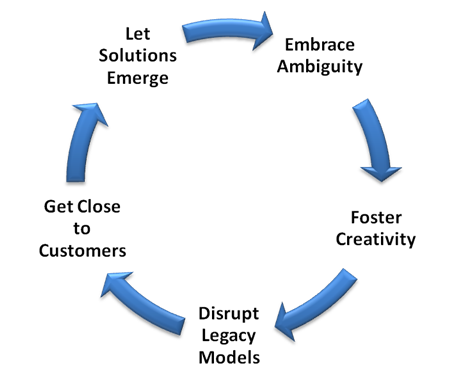
Continuous Innovation Loop
Certain behaviors are required to traverse the Continuous Innovation Loop. A new discipline is emerging called, “Complex Leadership.” It was introduced early in the 21st century, and is based on the application of complexity theory to the study of organizational behavior and the practice of leadership. What do complex leaders do? They let the solution emerge as they engage in unique leadership behaviors that foster innovation. This involves four steps:
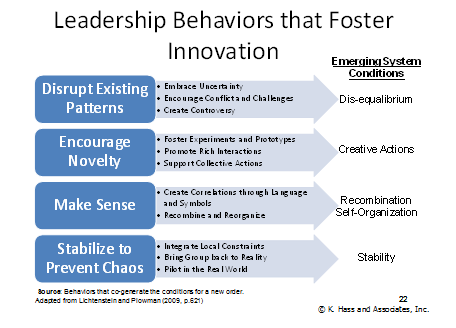
With so much riding on the results, companies must invest in the most valuable projects, providing value to customers and revenue to the company. However, studies reveal that few companies have effective portfolio management processes. The emerging roles of the enterprise and competitive-focused business analysts, serving as the complex leaders we need, have got to fill this gap in organizational capabilities by being the vital link between opportunity, innovation, investment, and value creation. To do this the business analyst brings together an expert team of individuals who are system thinkers and enjoy working in ambiguity, and leads them to break old rules and paradigms to discover breakthough ideas. Perhaps one of the reasons we don’t have effective portfolio management is because not enough business analysts are leading these important activities.[iii]
The Applied BA Capability Assessment – How does it Work?
Using an Applied BA Capability Assessment provides the information you need to baseline your applied capabilities and prepare your own learning and development plan. For a group of BAs, it can serve as valuable information to develop your organization’s professional develop program. The results provide a basis for BA workforce adjustments and/or realignment, training requirements, professional development activities, and specific mentoring and coaching needs.
Benchmarking: How You Compare with BAs Working on Similar Projects
The BA Applied Capability Assessment provides the opportunity to participate in a multi-dimensional assessment. The assessment collects basic demographic information about you, e.g., years of experience, time spent on BA activities versus project management or more technical tasks, amount of BA education, and capabilities performing BA work. It then compares the state of your BA capabilities to your peers and to BAs in the same industry. The information on how much time you spend on BA activities provides a view as to your actual capacity to deliver new business solutions. In addition to the benchmark report, you receive a customized professional development plan to guide your BA performance improvement and career development efforts.
Not Your Typical Competency Assessment
This is not your ordinary multiple-choice-type self-assessment using a rating scale. This approach provides an interpretive frame of reference to analyze your assessment responses; this assessment process exhibits strong reliability and validity when you respond candidly to each question. The following chart compares the BA Applied Capability Assessment approach to traditional competency assessments.
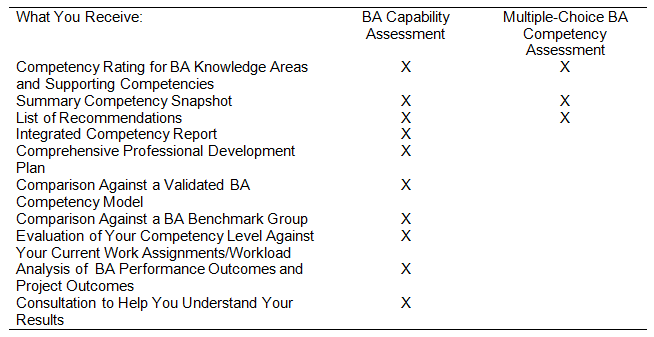
Sample Results
The reports you receive are customized to your specific work situation and provide you with relevant, prioritized recommendations to help you focus your learning and development efforts. If you use our online assessment, your customized reports arrive via email in PDF format. You may request a telephone coaching consultation or email consultation if you have any questions about your results and professional development recommendations. For organizational BA Workforce Assessments, organizational results and individual BA coaching sessions are performed at your place of work.
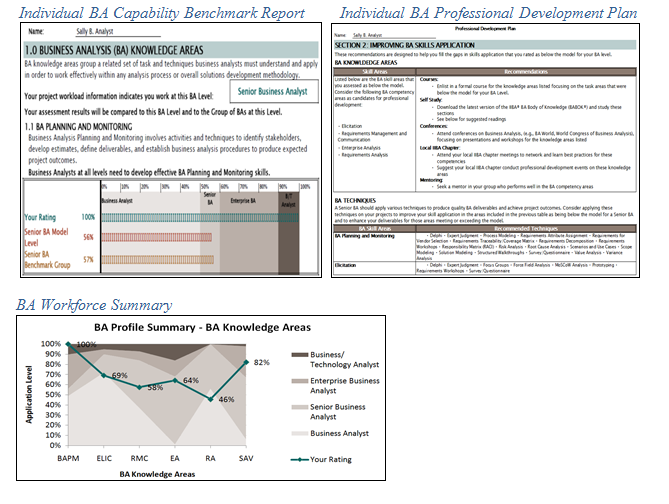
Don’t forget to leave your comments below.
[i] Carey Schwaber and Rob Karel, The New Business Analyst, Forrester Research, Inc., April 8, 2008
[ii] IBM Corporation. Turning product development into competitive advantage. Best practices for developing smarter products. IBM Executive Brief: Developing Competitive Products, July 2009, p 5.
[iii] Jim Brown, The Product Portfolio Management Benchmark Report: Achieving Maximum Product Value, Aberdeen Group, August 2006.

 The Agile Manifesto places customer collaboration over contract negotiation with a keen focus on a highly skilled, motivated team in constant interaction with the product and the customer at every phase of the project. As a result of this collaborative, customer-centric view, Agile requires more than the technical expertise needed to gather requirements, and develop and test new product lines. It requires soft skills, leadership competencies and an understanding of how to apply those skills in a more malleable, people-focused setting. As practitioners know, collaboration brings a set of challenges. With the Agile approach, project managers are called upon to team up with customers in a constant stakeholder dialogue.
The Agile Manifesto places customer collaboration over contract negotiation with a keen focus on a highly skilled, motivated team in constant interaction with the product and the customer at every phase of the project. As a result of this collaborative, customer-centric view, Agile requires more than the technical expertise needed to gather requirements, and develop and test new product lines. It requires soft skills, leadership competencies and an understanding of how to apply those skills in a more malleable, people-focused setting. As practitioners know, collaboration brings a set of challenges. With the Agile approach, project managers are called upon to team up with customers in a constant stakeholder dialogue.
